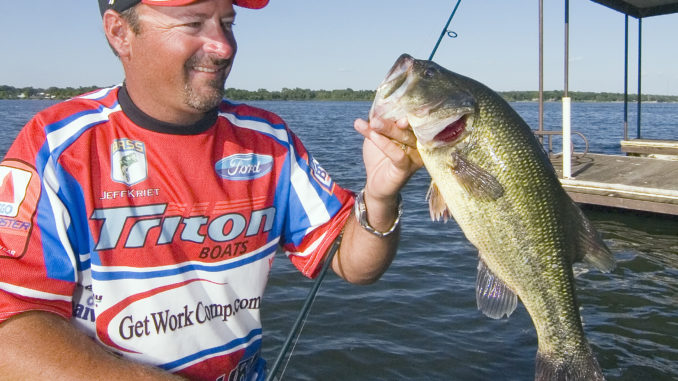
False River was once officially designated one of Louisiana’s quality lakes, giving testament to the potential of the old Mississippi River oxbow to produce stud bass. However, the lake was dropped from the quality-lake system in 1998 largely due to habitat degradation that made it unlikely False River would turn the corner and become a regular producer of lunkers.
“There’s a great fishery there, but there are definitely some habitat issues,” Louisiana Department of Wildlife and Fisheries biologist Rachel Walley told LouisianaSportsman.com last week.
But Walley said officials are again eyeing the lake, making plans that could result in the re-establishment of aquatic vegetation that all bass anglers know can lead to better fishing.
“There used to be aquatic vegetation on the north and south ends of the lake, as well as around the fringe of the lake,” LDWF’s Tim Morrison said.
That grass disappeared in the 1990s after the watershed of the lake was expanded dramatically, introducing larger amounts of sediment into the oxbow that essentially smothered vegetation in a layer of loose soil.
New vegetation could not be established because the mud wasn’t firm enough to hold roots.
“We tried planting vegetation in 1999-2000, and the soil was just too loose,” Morrison said.
At the same time, this layer of muck also decreased spawning habitat for bass, which require a hard bottom on which to create their beds each spring.
Morrison explained that False River’s shallow water held even more importance because of the hydrological make-up of the lake.
“False River is stratified, with the thermocline at about 5 feet,” he said.
Water below this thermocline is unsuitable for bass to live, meaning False River bass cannot move from shallow water to the depths in the middle of the lake like fish in other water ways do.
The solution to making these shallows again productive sounds almost too simple: Pull the plug on the lake until the water levels drop enough to expose the shallows.
“I proposed this back in the ’90s, but the (Pointe Coupee Parish) police jury opposed it,” Morrison said.
However, the current crop of parish leaders have expressed interest in taking steps to revitalize the lake, and a drawdown was again on the table.
“It’s a fishery-management tool, and we’ll use all the tools in our tool box,” Walley explained. “We can absolutely improve habitat on the lake.”
While there could be some other work added to the plan, she said a drawdown would remove a lot of the negatives of the loose sediment covering False River’s shallows.
“You get a compaction of soil, so you end up with a harder bottom,” Walley said. “That harder bottom provides nesting grounds (for bass) and allows vegetation to take root.”
She said decomposition of organic matter in the sediments also adds nutrients once water is brought back up to pool stage.
Walley said she was in the preliminary stages of planning for any move.
“We’re still in the data-collecting stages,” she explained. “I’m looking at historical data, and I’m collecting new data.”
Once a plan has been developed and approved by departmental leaders, a process Walley said could take two to three months, parish police jurors will have to approve any move.
“The police jury has to vote on it because they control the light-house (water) control structure,” she said.
Of course, a drawdown will do nothing to reduce the amount of sediment flowing into the lake, so Walley said she was working on that part of the equation, as well.
“We will have recommendations to reduce the amount of additional sediments introduced into the lake,” she said.
